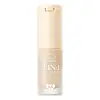What's inside
What's inside
 Key Ingredients
Key Ingredients

 Benefits
Benefits

 Concerns
Concerns

 Ingredients Side-by-side
Ingredients Side-by-side

Cyclopentasiloxane
EmollientButylene Glycol
HumectantVinyl Dimethicone/Lauryl Dimethicone Crosspolymer
Stearyl Dimethicone
EmollientOctadecene
SolventPEG-10 Dimethicone
Skin ConditioningCetyl PEG/PPG-10/1 Dimethicone
EmulsifyingDimethicone
EmollientButylene Glycol Dicaprylate/Dicaprate
EmollientAcrylates/Polytrimethylsiloxymethacrylate Copolymer
Skin ConditioningPolymethyl Methacrylate
Silica
AbrasiveAlumina
AbrasiveAcrylates/Dimethicone Copolymer
Skin ConditioningIsododecane
EmollientMethyl Trimethicone
Skin ConditioningTrimethylsiloxysilicate
EmollientQuaternium-18 Bentonite
Magnesium Sulfate
Phenoxyethanol
PreservativeHydroxyacetophenone
AntioxidantEthylhexyl Palmitate
EmollientTrihydroxystearin
Skin ConditioningSodium Hyaluronate
HumectantGlucomannan
Skin ConditioningTocopheryl Acetate
AntioxidantMagnesium Stearate
Cosmetic ColorantAluminum Hydroxide
EmollientTriethoxycaprylylsilane
Cyclopentasiloxane, Butylene Glycol, Vinyl Dimethicone/Lauryl Dimethicone Crosspolymer, Stearyl Dimethicone, Octadecene, PEG-10 Dimethicone, Cetyl PEG/PPG-10/1 Dimethicone, Dimethicone, Butylene Glycol Dicaprylate/Dicaprate, Acrylates/Polytrimethylsiloxymethacrylate Copolymer, Polymethyl Methacrylate, Silica, Alumina, Acrylates/Dimethicone Copolymer, Isododecane, Methyl Trimethicone, Trimethylsiloxysilicate, Quaternium-18 Bentonite, Magnesium Sulfate, Phenoxyethanol, Hydroxyacetophenone, Ethylhexyl Palmitate, Trihydroxystearin, Sodium Hyaluronate, Glucomannan, Tocopheryl Acetate, Magnesium Stearate, Aluminum Hydroxide, Triethoxycaprylylsilane
Water
Skin ConditioningCyclopentasiloxane
EmollientTrimethylsiloxysilicate
EmollientButylene Glycol
HumectantEthylhexyl Methoxycinnamate
UV AbsorberIsododecane
EmollientCetyl PEG/PPG-10/1 Dimethicone
EmulsifyingMica
Cosmetic ColorantPolymethylsilsesquioxane
Titanium Dioxide
Cosmetic ColorantQuaternium-90 Bentonite
Hydroxyapatite
AbrasivePEG-10 Dimethicone
Skin ConditioningPolyglyceryl-4 Diisostearate/Polyhydroxystearate/Sebacate
EmulsifyingZinc Oxide
Cosmetic ColorantMagnesium Sulfate
Phenoxyethanol
PreservativeAluminum Hydroxide
EmollientPerlite
AbsorbentStearic Acid
CleansingCI 77220
Cosmetic ColorantParfum
MaskingTriethoxycaprylylsilane
Ethylhexylglycerin
Skin ConditioningBrassica Campestris Seed Oil
Skin ConditioningChrysanthellum Indicum Extract
Skin ConditioningCentella Asiatica Flower/Leaf/Stem Extract
Skin ConditioningCalendula Officinalis Flower Extract
MaskingMagnolia Sieboldii Extract
Skin ConditioningHibiscus Mutabilis Flower Extract
Skin ConditioningCI 77891
Cosmetic ColorantCI 77491
Cosmetic ColorantCI 77492
Cosmetic ColorantCI 77499
Cosmetic ColorantWater, Cyclopentasiloxane, Trimethylsiloxysilicate, Butylene Glycol, Ethylhexyl Methoxycinnamate, Isododecane, Cetyl PEG/PPG-10/1 Dimethicone, Mica, Polymethylsilsesquioxane, Titanium Dioxide, Quaternium-90 Bentonite, Hydroxyapatite, PEG-10 Dimethicone, Polyglyceryl-4 Diisostearate/Polyhydroxystearate/Sebacate, Zinc Oxide, Magnesium Sulfate, Phenoxyethanol, Aluminum Hydroxide, Perlite, Stearic Acid, CI 77220, Parfum, Triethoxycaprylylsilane, Ethylhexylglycerin, Brassica Campestris Seed Oil, Chrysanthellum Indicum Extract, Centella Asiatica Flower/Leaf/Stem Extract, Calendula Officinalis Flower Extract, Magnolia Sieboldii Extract, Hibiscus Mutabilis Flower Extract, CI 77891, CI 77491, CI 77492, CI 77499
Ingredients Explained
These ingredients are found in both products.
Ingredients higher up in an ingredient list are typically present in a larger amount.
Aluminum Hydroxide is a form of aluminum. It can be naturally found in nature as the mineral gibbsite. In cosmetics, Aluminum Hydroxide is used as a colorant, pH adjuster, and absorbent.
As a colorant, Aluminum Hydroxide may add opacity, or reduce the transparency. Aluminum hydroxide is contains both basic and acidic properties.
According to manufacturers, this ingredient is an emollient and humectant. This means it helps hydrate the skin.
In medicine, this ingredient is used to help relieve heartburn and help heal ulcers.
There is currently no credible scientific evidence linking aluminum hydroxide in cosmetics to increased cancer risk.
Major health organizations allow the use of aluminum hydroxide in personal care products and have not flagged it as a carcinogenic risk at typical usage levels.
Learn more about Aluminum HydroxideButylene Glycol (or BG) is used within cosmetic products for a few different reasons:
Overall, Butylene Glycol is a safe and well-rounded ingredient that works well with other ingredients.
Though this ingredient works well with most skin types, some people with sensitive skin may experience a reaction such as allergic rashes, closed comedones, or itchiness.
Learn more about Butylene GlycolThis ingredient is a high molecular weight silicone. It has emulsifying and skin conditioning properties.
Cyclopentasiloxane, or D5, is a silicone used to improve texture of products and trap moisture.
D5 is considered lightweight and volatile. Volatile means it evaporates quickly after application. Once evaporated, D5 leaves a thin barrier that helps keep skin hydrated.
It is also an emollient. Emollients help soften the skin and prevent water loss. Silicones create a silky texture in products. D5 helps other ingredients become more spreadable.
Studies show D5 is safe to use in skincare products. We recommend speaking with a skincare professional if you have concerns.
Learn more about CyclopentasiloxaneIsododecane is a fragrance, emollient, and solvent.
As an emollient, it helps your skin stay soft and hydrated. Emollients help trap moisture into your skin.
Isododecane's role as a solvent makes it a great texture enhancer. It spreads smoothly on skin and does not leave a sticky feeling behind. Isododecane also helps prevent color transfer in makeup products.
Isododecane is not absorbed into skin.
Learn more about IsododecaneMagnesium Sulfate is a salt. More specifically, it is an epsom salt, or the bath salt used to help relieve muscle aches.
Despite having ‘sulfate’ in the name, it isn’t a surfactant or cleansing agent like sodium lauryl sulfate. Unlike those sulfates, magnesium sulfate doesn’t have the same cleansing or foaming properties (it's simply a type of salt).
In cosmetics, Magnesium Sulfate is used to thicken a product or help dilute other solids. It is a non-reactive and non-irritating ingredient.
One study shows magnesium deficiency may lead to inflammation of the skin. Applying magnesium topically may help reduce inflammation.
You can find this ingredient in sea water or mineral deposits.
Learn more about Magnesium SulfatePeg-10 Dimethicone is silicone with conditioner and emulsifier properties. It mostly acts as an emollient in skincare and and humectant in haircare.
According to the manufacturer, acidic formulations decrease the stability of this ingredient. It works best in neutral or near neutral formulations.
Phenoxyethanol is a preservative that has germicide, antimicrobial, and aromatic properties. Studies show that phenoxyethanol can prevent microbial growth. By itself, it has a scent that is similar to that of a rose.
It's often used in formulations along with Caprylyl Glycol to preserve the shelf life of products.
Triethoxycaprylylsilane is a silicone used to bind and stabilize ingredients.
As an emulsifier, it helps prevent ingredients from separating. This can help elongate the shelf life of products.
Triethoxycaprylylsilane is often used to coat mineral sunscreens ingredients to help give a better feel. It also helps reduce oxidative stress in sunscreens.
Learn more about TriethoxycaprylylsilaneThis silicone is an emollient. Emollients create a thin film on the skin to prevent moisture from escaping.
It is not soluble in water and helps increase water-resistance in products.
According to a manufacturer, it can blend seamlessly with silicone oils, such as Cyclopentasiloxane.
Learn more about Trimethylsiloxysilicate